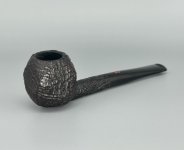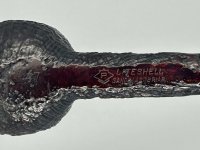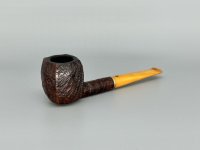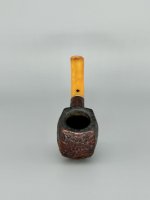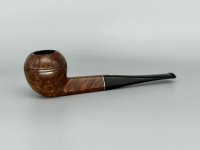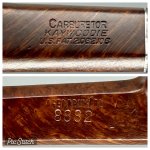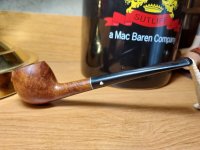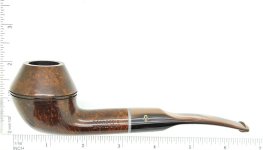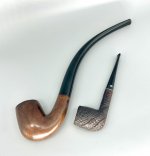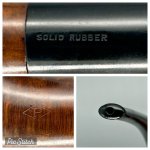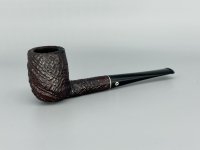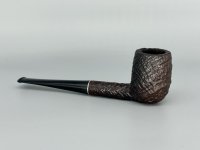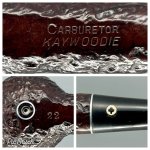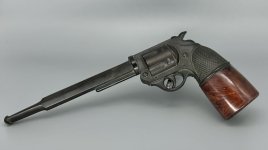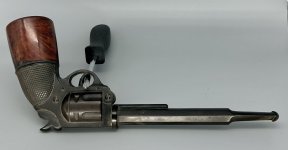Show Off Your Kaywoodie Pipes
- Thread starter crashthegrey
- Start date
You are using an out of date browser. It may not display this or other websites correctly.
You should upgrade or use an alternative browser.
You should upgrade or use an alternative browser.
SmokingPipes.com Updates
Watch for Updates Twice a Week
The Premier Briar pipe company predates the 1922 creation of the Reis Premier Briar Pipe Co. so yes there are Premier pipes from the 20’s and earlier. But if they have a two digit shape number that corresponds to a Kaywoodie shape it’s probably from the 30’s or later. The shape of the button is a pretty good indication of age as well.I see someone on FB claiming their Beverly Premier is 100 years old. I'm wondering how they can date it. It's "Italian Bruyere." I'm trying to remember what that means but maybe that phrase dates it. It's a beautiful pipe but I'm kind of skeptical it's '20s. I'm wondering if any of them can be dated although maybe the stingers give a clue? Is there any place on line that lists their lines of pipes? I see nothing. There are shape numbers and model names on the pipes but I see no guides to these anywhere.
Wow. That's a fine looking pipe actually. Very fine. Does it have a corkscrew stinger with no holes? Very nice.@milk Here is a Premier, Paneled Apple, LITESHELL, 47 from the 30’sView attachment 204472View attachment 204473
It has no stinger, but I do have a Premier with a spiral stinger, and it is 100% from the 20’sWow. That's a fine looking pipe actually. Very fine. Does it have a corkscrew stinger with no holes? Very nice.
It's tough to know where to begin with this one. Kaywoodie and its related entities form a story fully as convoluted as the Cadogan analogue on the other side of the Atlantic. Worsening the tangle, Kaywoodie and Cadogan held interlocking interests in subsidiaries at one point to facilitate each of their export sales. To a large extent the Pipedia version is correct, as far as it goes, although details are sometimes seriously wrong. I've put off doing anything about it because of the complexity and multiplicity of people, companies, and events. I actually started a draft a dozen years ago but had to set it aside due to more pressing obligations (i.e. earning a living); it'll be a retirement project assuming I live that long. For now I'll make a few points and provide an extremely brief chronology. Hopefully this will provide a little incremental clarity.
First the prefatory remarks:
-it's almost impossible to make sense of this mess without know the individuals involved; each entity brought its own people into the mix, and in many cases they (or their children) played key roles
-think of an org chart of hideous complexity with shifting lines leading from one box to another, criss-crossing like cooked spaghetti dumped on the floor. To really understand what happened you need to create multiple parallel timelines showing when companies were created, merged, bought, and sold until you wind up with the SM Frank of today.
Here's a grossly simplified narrative. Each of these entities could easily be the subject of a chapter in a tediously long book:
-The oldest business is KB&B (1851), the key men were Leopold Kaufmann and Solomon Bondy, later joined by Leopold's brother Gottlieb Kaufmann
-Next came Reiss Bros & Co (c. 1886); the key men were brothers Julius and Otto Reiss (another brother named Nathan was in the tobacco leaf business), plus their sister Marie Reiss' husband Nathan Burger, and most importantly later on Marie's son Jacob (later Anglicized to John) David Burger; he played the pivotal role in the industry consolidation which happened a few decades later
-Next comes the Premier Briar Pipe Co (June 13, 1913), formed by Carl Hirsch (who immediately prior to this foray into pipemaking on a large scale had started another company which had gone bankrupt about the same time this venture was launched). Carl's nephew Rudolph Hirsch was to play an important leadership role in the combined businesses many years later
-Reiss-Premier Pipe Co was formed as the result of a merger between Reiss Bros and Premier Briar Pipe in 1920. The deal was orchestrated by John Burger (by this time his father and two uncles, the three original partners in Reiss Bros, were long dead) who ran the combined entity
-In August 1926 Reiss-Premier purchased a controlling interest in KB&B and operated it as "an associate company". Another "associate company" at that time was the Civic Premier Pipe Co, which was designated as the American representative of the UK's Civic Pipe Company, Ltd (the relationship between Cadogan and Reiss-Premier et al is worth a chapter of its own; this arrangement of course accounts for the appearance of the made-in-England Drinkless pipes appearing at this time). In the wake of the KB&B deal Reiss-Premier grew to 300 workers
-Five months before the crash of 1929, in April of that year, Burger negotiated a partial sale of Reiss-Premier to United Cigar Stores of America under David Schulte in the form of a stock swap. United Cigars purchased 49% of the company for equity in United Cigar valued at $735,000
-Meanwhile there is a parallel path involving the progress of Samuel Morris Frank (S. M. Frank & Co est. 1900) as he grew his business both organically and through acquisition. Two examples of the latter are the purchase of Manhattan Briar in 1922 from American Tobacco, and more significantly of Wm Demuth & Co bought from D. A. Schulte Inc (a subsidiary of the Schulte Retail Store Corp) in 1937. Here again the story is complicated but in brief Schulte had bought Demuth in the Spring of 1927. By the mid Thirties the Depression had taken a severe toll on Schulte's business and it was in financial distress. A legal reorganization that started in 1936 continued into 1937, in which year Schulte sold Demuth to S. M. Frank to raise some much needed cash
-After the acquisition Frank, driven at least in part by an impending loss of its own factory due to eminent domain, promptly consolidated its production into the Demuth Richmond Hill facility
-Meanwhile back at Reiss-Premier when John Burger died in 1944, Rudolph Hirsch wound up winning the succession contest to run the combined businesses
-Just six years later Associated Products, a Chicago manufacturer of deodorants, bought Reiss-Premier at the very end of 1950. The reasons for this are hazy to me; I suspect but can't prove it was yet another example of the unrelated diversification strategy which led to the creation of so many disparate conglomerates in the years after WW2 (e.g. ITT, GE, etc)
-Associated Products held the business for five years before selling it to S. M. Frank in 1955, which retains Reiss-Premier to this day
So there you have a light sketch of how the consolidation of most of the major American pipe manufacturers took place. I'll wrap up by making two smaller points. First, Kaywoodie as a brand dates to approximately March 1919. It was a deliberate renaming of the Dinwoodie, which itself dated from November 1916. Text from an ad to the trade dated March 1 1919: "In order to associate the name of the Dinwoodie pipe with the name of our house, it will hereafter be known as the Kaywoodie. Kay will serve to identify this superlative Italian Bruyere pipe with our name, KAUFMANN BROS. & BONDY." Second, why people refer to the Drinkless as a patent is unclear to me. While filed with the US Patent Office the actual grant (213598) is clearly for a trademark, i.e. the use of the word "Drinkless" in this context, not any internals to the pipe.
In reviewing the above I realize for those interested in Kaywoodie it is entirely to short, while for those who are not it must be a snooze fest of epic proportions. I apologize to both groups.
First the prefatory remarks:
-it's almost impossible to make sense of this mess without know the individuals involved; each entity brought its own people into the mix, and in many cases they (or their children) played key roles
-think of an org chart of hideous complexity with shifting lines leading from one box to another, criss-crossing like cooked spaghetti dumped on the floor. To really understand what happened you need to create multiple parallel timelines showing when companies were created, merged, bought, and sold until you wind up with the SM Frank of today.
Here's a grossly simplified narrative. Each of these entities could easily be the subject of a chapter in a tediously long book:
-The oldest business is KB&B (1851), the key men were Leopold Kaufmann and Solomon Bondy, later joined by Leopold's brother Gottlieb Kaufmann
-Next came Reiss Bros & Co (c. 1886); the key men were brothers Julius and Otto Reiss (another brother named Nathan was in the tobacco leaf business), plus their sister Marie Reiss' husband Nathan Burger, and most importantly later on Marie's son Jacob (later Anglicized to John) David Burger; he played the pivotal role in the industry consolidation which happened a few decades later
-Next comes the Premier Briar Pipe Co (June 13, 1913), formed by Carl Hirsch (who immediately prior to this foray into pipemaking on a large scale had started another company which had gone bankrupt about the same time this venture was launched). Carl's nephew Rudolph Hirsch was to play an important leadership role in the combined businesses many years later
-Reiss-Premier Pipe Co was formed as the result of a merger between Reiss Bros and Premier Briar Pipe in 1920. The deal was orchestrated by John Burger (by this time his father and two uncles, the three original partners in Reiss Bros, were long dead) who ran the combined entity
-In August 1926 Reiss-Premier purchased a controlling interest in KB&B and operated it as "an associate company". Another "associate company" at that time was the Civic Premier Pipe Co, which was designated as the American representative of the UK's Civic Pipe Company, Ltd (the relationship between Cadogan and Reiss-Premier et al is worth a chapter of its own; this arrangement of course accounts for the appearance of the made-in-England Drinkless pipes appearing at this time). In the wake of the KB&B deal Reiss-Premier grew to 300 workers
-Five months before the crash of 1929, in April of that year, Burger negotiated a partial sale of Reiss-Premier to United Cigar Stores of America under David Schulte in the form of a stock swap. United Cigars purchased 49% of the company for equity in United Cigar valued at $735,000
-Meanwhile there is a parallel path involving the progress of Samuel Morris Frank (S. M. Frank & Co est. 1900) as he grew his business both organically and through acquisition. Two examples of the latter are the purchase of Manhattan Briar in 1922 from American Tobacco, and more significantly of Wm Demuth & Co bought from D. A. Schulte Inc (a subsidiary of the Schulte Retail Store Corp) in 1937. Here again the story is complicated but in brief Schulte had bought Demuth in the Spring of 1927. By the mid Thirties the Depression had taken a severe toll on Schulte's business and it was in financial distress. A legal reorganization that started in 1936 continued into 1937, in which year Schulte sold Demuth to S. M. Frank to raise some much needed cash
-After the acquisition Frank, driven at least in part by an impending loss of its own factory due to eminent domain, promptly consolidated its production into the Demuth Richmond Hill facility
-Meanwhile back at Reiss-Premier when John Burger died in 1944, Rudolph Hirsch wound up winning the succession contest to run the combined businesses
-Just six years later Associated Products, a Chicago manufacturer of deodorants, bought Reiss-Premier at the very end of 1950. The reasons for this are hazy to me; I suspect but can't prove it was yet another example of the unrelated diversification strategy which led to the creation of so many disparate conglomerates in the years after WW2 (e.g. ITT, GE, etc)
-Associated Products held the business for five years before selling it to S. M. Frank in 1955, which retains Reiss-Premier to this day
So there you have a light sketch of how the consolidation of most of the major American pipe manufacturers took place. I'll wrap up by making two smaller points. First, Kaywoodie as a brand dates to approximately March 1919. It was a deliberate renaming of the Dinwoodie, which itself dated from November 1916. Text from an ad to the trade dated March 1 1919: "In order to associate the name of the Dinwoodie pipe with the name of our house, it will hereafter be known as the Kaywoodie. Kay will serve to identify this superlative Italian Bruyere pipe with our name, KAUFMANN BROS. & BONDY." Second, why people refer to the Drinkless as a patent is unclear to me. While filed with the US Patent Office the actual grant (213598) is clearly for a trademark, i.e. the use of the word "Drinkless" in this context, not any internals to the pipe.
In reviewing the above I realize for those interested in Kaywoodie it is entirely to short, while for those who are not it must be a snooze fest of epic proportions. I apologize to both groups.
Last edited:
Copy/paste or typed? That's what I wanna know.....It's tough to know where to begin with this one. Kaywoodie and its related entities form a story fully as convoluted as the Cadogan analogue on the other side of the Atlantic. Worsening the tangle, Kaywoodie and Cadogan held interlocking interests in subsidiaries at one point to facilitate each of their export sales. To a large extent the Pipedia version is correct, as far as it goes, although details are sometimes seriously wrong. I've put off doing anything about it because of the complexity and multiplicity of people, companies, and events. I actually started a draft a dozen years ago but had to set it aside due to more pressing obligations (i.e. earning a living); it'll be a retirement project assuming I live that long. For now I'll make a few points and provide an extremely brief chronology. Hopefully this will provide a little incremental clarity.
First the prefatory remarks:
-it's almost impossible to make sense of this mess without know the individuals involved; each entity brought its own people into the mix, and in many cases they (or their children) played key roles
-think of an org chart of hideous complexity with shifting lines leading from one box to another, criss-crossing like cooked spaghetti dumped on the floor. To really understand what happened you need to create multiple parallel timelines showing when companies were created, merged, bought, and sold until you wind up with the SM Frank of today.
Here's a grossly simplified narrative. Each of these entities could easily be the subject of a chapter in a tediously long book:
-The oldest business is KB&B (1851), the key men were Leopold Kaufmann and Solomon Bondy, later joined by Leopold's brother Gottlieb Kaufmann
-Next came Reiss Bros & Co (c. 1886); the key men were brothers Julius and Otto Reiss (another brother named Nathan was in the tobacco leaf business), plus their sister Marie Reiss' husband Nathan Burger, and most importantly later on Marie's son Jacob (later Anglicized to John) David Burger; he played the pivotal role in the industry consolidation which happened a few decades later
-Next comes the Premier Briar Pipe Co (June 13, 1913), formed by Carl Hirsch (who immediately prior to this foray into pipemaking on a large scale had started another company which had gone bankrupt about the same time this venture was launched). Carl's nephew Rudolph Hirsch was to play an important leadership role in the combined businesses many years later
-Reiss-Premier Pipe Co was formed as the result of a merger between Reiss Bros and Premier Briar Pipe in 1920. The deal was orchestrated by John Burger (by this time his father and two uncles, the three original partners in Reiss Bros, were long dead) who ran the combined entity
-In August 1926 Reiss-Premier purchased a controlling interest in KB&B and operated it as "an associate company". Another "associate company" at that time was the Civic Premier Pipe Co, which was designated as the American representative of the UK's Civic Pipe Company, Ltd (the relationship between Cadogan and Reiss-Premier et al is worth a chapter of its own; this arrangement of course accounts for the appearance of the made-in-England Drinkless pipes appearing at this time). In the wake of the KB&B deal Reiss-Premier grew to 300 workers
-Five months before the crash of 1929, in April of that year, Burger negotiated a partial sale of Reiss-Premier to United Cigar Stores of America under David Schulte in the form of a stock swap. United Cigars purchased 49% of the company for equity in United Cigar valued at $735,000
-Meanwhile there is a parallel path involving the progress of Samuel Morris Frank (S. M. Frank & Co est. 1900) as he grew his business both organically and through acquisition. Two examples of the latter are the purchase of Manhattan Briar in 1922 from American Tobacco, and more significantly of Wm Demuth & Co bought from D. A. Schulte Inc (a subsidiary of the Schulte Retail Store Corp) in 1937. Here again the story is complicated but in brief Schulte had bought Demuth in the Spring of 1927. By the mid Thirties the Depression had taken a severe toll on Schulte's business and it was in financial distress. A legal reorganization that started in 1936 continued into 1937, in which year Schulte sold Demuth to S. M. Frank to raise some much needed cash
-After the acquisition Frank, driven at least in part by an impending loss of its own factory due to eminent domain, promptly consolidated its production into the Demuth Richmond Hill facility
-Meanwhile back at Reiss-Premier when John Burger died in 1944, Rudolph Hirsch wound up winning the succession contest to run the combined businesses
-Just six years later Associated Products, a Chicago manufacturer of deodorants, bought Reiss-Premier at the very end of 1950. The reasons for this are hazy to me; I suspect but can't prove it was yet another example of the unrelated diversification strategy which led to the creation of so many disparate conglomerates in the years after WW2 (e.g. ITT, GE, etc)
-Associated Products held the business for five years before selling it to S. M. Frank in 1955, which retains Reiss-Premier to this day
So there you have a light sketch of how the consolidation of most of the major American pipe manufacturers took place. I'll wrap up by making two smaller points. First, Kaywoodie as a brand dates to approximately March 1919. It was a deliberate renaming of the Dinwoodie, which itself dated from November 1916. Text from an ad to the trade dated March 1 1919: "In order to associate the name of the Dinwoodie pipe with the name of our house, it will hereafter be known as the Kaywoodie. Kay will serve to identify this superlative Italian Bruyere pipe with our name, KAUFMANN BROS. & BONDY." Second, why people refer to the Drinkless as a patent is unclear to me. While filed with the US Patent Office the actual grant (213598) is clearly for a trademark, i.e. the use of the word "Drinkless" in this context, not any internals to the pipe.
In reviewing the above I realize for those interested in Kaywoodie it is entirely to short, while for those who are not it must be a snooze fest of epic proportions. I apologize to both groups.
Copy/paste or typed? That's what I wanna know.....
Why would anyone do their own research or typing when ChatGPT is available?
Regarding if the latter: transcribed, or from memory?Copy/paste or typed? That's what I wanna know.....
Regarding if the latter: transcribed, or from memory?
Neither. I’m an aging Boomer; the last time I relied on my memory was in the 1990s. My wife pins a note with our address on it to my button down shirt every time I leave the house. Everything I do is from scratch. As far as research is concerned I’m an old school artisan.
I should probably add I have trust issues. If I haven’t proven something to my own satisfaction it gets an asterisk at best. In my first job forty years ago we called accepting unproven beliefs “drinking your own bath water”. I tried hard not to do it then and I try hard not to do it now. Not infrequently building something de novo turns out to be quicker in the end than building on someone else’s foundation.
Last edited:
It's tough to know where to begin with this one. Kaywoodie and its related entities form a story fully as convoluted as the Cadogan analogue on the other side of the Atlantic. Worsening the tangle, Kaywoodie and Cadogan held interlocking interests in subsidiaries at one point to facilitate each of their export sales. To a large extent the Pipedia version is correct, as far as it goes, although details are sometimes seriously wrong. I've put off doing anything about it because of the complexity and multiplicity of people, companies, and events. I actually started a draft a dozen years ago but had to set it aside due to more pressing obligations (i.e. earning a living); it'll be a retirement project assuming I live that long. For now I'll make a few points and provide an extremely brief chronology. Hopefully this will provide a little incremental clarity.
First the prefatory remarks:
-it's almost impossible to make sense of this mess without know the individuals involved; each entity brought its own people into the mix, and in many cases they (or their children) played key roles
-think of an org chart of hideous complexity with shifting lines leading from one box to another, criss-crossing like cooked spaghetti dumped on the floor. To really understand what happened you need to create multiple parallel timelines showing when companies were created, merged, bought, and sold until you wind up with the SM Frank of today.
Here's a grossly simplified narrative. Each of these entities could easily be the subject of a chapter in a tediously long book:
-The oldest business is KB&B (1851), the key men were Leopold Kaufmann and Solomon Bondy, later joined by Leopold's brother Gottlieb Kaufmann
-Next came Reiss Bros & Co (c. 1886); the key men were brothers Julius and Otto Reiss (another brother named Nathan was in the tobacco leaf business), plus their sister Marie Reiss' husband Nathan Burger, and most importantly later on Marie's son Jacob (later Anglicized to John) David Burger; he played the pivotal role in the industry consolidation which happened a few decades later
-Next comes the Premier Briar Pipe Co (June 13, 1913), formed by Carl Hirsch (who immediately prior to this foray into pipemaking on a large scale had started another company which had gone bankrupt about the same time this venture was launched). Carl's nephew Rudolph Hirsch was to play an important leadership role in the combined businesses many years later
-Reiss-Premier Pipe Co was formed as the result of a merger between Reiss Bros and Premier Briar Pipe in 1920. The deal was orchestrated by John Burger (by this time his father and two uncles, the three original partners in Reiss Bros, were long dead) who ran the combined entity
-In August 1926 Reiss-Premier purchased a controlling interest in KB&B and operated it as "an associate company". Another "associate company" at that time was the Civic Premier Pipe Co, which was designated as the American representative of the UK's Civic Pipe Company, Ltd (the relationship between Cadogan and Reiss-Premier et al is worth a chapter of its own; this arrangement of course accounts for the appearance of the made-in-England Drinkless pipes appearing at this time). In the wake of the KB&B deal Reiss-Premier grew to 300 workers
-Five months before the crash of 1929, in April of that year, Burger negotiated a partial sale of Reiss-Premier to United Cigar Stores of America under David Schulte in the form of a stock swap. United Cigars purchased 49% of the company for equity in United Cigar valued at $735,000
-Meanwhile there is a parallel path involving the progress of Samuel Morris Frank (S. M. Frank & Co est. 1900) as he grew his business both organically and through acquisition. Two examples of the latter are the purchase of Manhattan Briar in 1922 from American Tobacco, and more significantly of Wm Demuth & Co bought from D. A. Schulte Inc (a subsidiary of the Schulte Retail Store Corp) in 1937. Here again the story is complicated but in brief Schulte had bought Demuth in the Spring of 1927. By the mid Thirties the Depression had taken a severe toll on Schulte's business and it was in financial distress. A legal reorganization that started in 1936 continued into 1937, in which year Schulte sold Demuth to S. M. Frank to raise some much needed cash
-After the acquisition Frank, driven at least in part by an impending loss of its own factory due to eminent domain, promptly consolidated its production into the Demuth Richmond Hill facility
-Meanwhile back at Reiss-Premier when John Burger died in 1944, Rudolph Hirsch wound up winning the succession contest to run the combined businesses
-Just six years later Associated Products, a Chicago manufacturer of deodorants, bought Reiss-Premier at the very end of 1950. The reasons for this are hazy to me; I suspect but can't prove it was yet another example of the unrelated diversification strategy which led to the creation of so many disparate conglomerates in the years after WW2 (e.g. ITT, GE, etc)
-Associated Products held the business for five years before selling it to S. M. Frank in 1955, which retains Reiss-Premier to this day
So there you have a light sketch of how the consolidation of most of the major American pipe manufacturers took place. I'll wrap up by making two smaller points. First, Kaywoodie as a brand dates to approximately March 1919. It was a deliberate renaming of the Dinwoodie, which itself dated from November 1916. Text from an ad to the trade dated March 1 1919: "In order to associate the name of the Dinwoodie pipe with the name of our house, it will hereafter be known as the Kaywoodie. Kay will serve to identify this superlative Italian Bruyere pipe with our name, KAUFMANN BROS. & BONDY." Second, why people refer to the Drinkless as a patent is unclear to me. While filed with the US Patent Office the actual grant (213598) is clearly for a trademark, i.e. the use of the word "Drinkless" in this context, not any internals to the pipe.
In reviewing the above I realize for those interested in Kaywoodie it is entirely to short, while for those who are not it must be a snooze fest of epic proportions. I apologize to both groups.
I've now had about as many older Kaywoodies, as I've had new. And I can't tell a quality difference between the two. I'd say they certainly still got it! That's a nice one! Real hard to come by the smooth ones these days!I just ordered this Kaywoodie Gold Elite from WV Smoke Shop
View attachment 205057
You are making me jealous man!!A giant Premier bent billiard 1913-19ish shown with a Kaywoodie billiard for size reference.View attachment 205386View attachment 205387
A closer look at the Kaywoodie Billiard. A beautifully craggy sandblast 22 (medium billiard long stem) Carburetor 1939-41View attachment 205388View attachment 205389
View attachment 205390
A pre 1919 C.P.F. (KB&B) revolver pipe with a screw on bowl.View attachment 205391View attachment 205392
This is still too much and leaves my head spinning but can I ask you about a specific pipe? You’ve certainly got a clearer explanation than pipedia or, at least, it’s hard to track pipedia. I see they’ve a listing for Reiss-Premier Corp which they followed Reiss-Premier Pipes. Anyway, do you know about this one pipe they have pictured called the “Premo”? Here’s a picture from pipedia.WIt's tough to know where to begin with this one. Kaywoodie and its related entities form a story fully as convoluted as the Cadogan analogue on the other side of the Atlantic. Worsening the tangle, Kaywoodie and Cadogan held interlocking interests in subsidiaries at one point to facilitate each of their export sales. To a large extent the Pipedia version is correct, as far as it goes, although details are sometimes seriously wrong. I've put off doing anything about it because of the complexity and multiplicity of people, companies, and events. I actually started a draft a dozen years ago but had to set it aside due to more pressing obligations (i.e. earning a living); it'll be a retirement project assuming I live that long. For now I'll make a few points and provide an extremely brief chronology. Hopefully this will provide a little incremental clarity.
First the prefatory remarks:
-it's almost impossible to make sense of this mess without know the individuals involved; each entity brought its own people into the mix, and in many cases they (or their children) played key roles
-think of an org chart of hideous complexity with shifting lines leading from one box to another, criss-crossing like cooked spaghetti dumped on the floor. To really understand what happened you need to create multiple parallel timelines showing when companies were created, merged, bought, and sold until you wind up with the SM Frank of today.
Here's a grossly simplified narrative. Each of these entities could easily be the subject of a chapter in a tediously long book:
-The oldest business is KB&B (1851), the key men were Leopold Kaufmann and Solomon Bondy, later joined by Leopold's brother Gottlieb Kaufmann
-Next came Reiss Bros & Co (c. 1886); the key men were brothers Julius and Otto Reiss (another brother named Nathan was in the tobacco leaf business), plus their sister Marie Reiss' husband Nathan Burger, and most importantly later on Marie's son Jacob (later Anglicized to John) David Burger; he played the pivotal role in the industry consolidation which happened a few decades later
-Next comes the Premier Briar Pipe Co (June 13, 1913), formed by Carl Hirsch (who immediately prior to this foray into pipemaking on a large scale had started another company which had gone bankrupt about the same time this venture was launched). Carl's nephew Rudolph Hirsch was to play an important leadership role in the combined businesses many years later
-Reiss-Premier Pipe Co was formed as the result of a merger between Reiss Bros and Premier Briar Pipe in 1920. The deal was orchestrated by John Burger (by this time his father and two uncles, the three original partners in Reiss Bros, were long dead) who ran the combined entity
-In August 1926 Reiss-Premier purchased a controlling interest in KB&B and operated it as "an associate company". Another "associate company" at that time was the Civic Premier Pipe Co, which was designated as the American representative of the UK's Civic Pipe Company, Ltd (the relationship between Cadogan and Reiss-Premier et al is worth a chapter of its own; this arrangement of course accounts for the appearance of the made-in-England Drinkless pipes appearing at this time). In the wake of the KB&B deal Reiss-Premier grew to 300 workers
-Five months before the crash of 1929, in April of that year, Burger negotiated a partial sale of Reiss-Premier to United Cigar Stores of America under David Schulte in the form of a stock swap. United Cigars purchased 49% of the company for equity in United Cigar valued at $735,000
-Meanwhile there is a parallel path involving the progress of Samuel Morris Frank (S. M. Frank & Co est. 1900) as he grew his business both organically and through acquisition. Two examples of the latter are the purchase of Manhattan Briar in 1922 from American Tobacco, and more significantly of Wm Demuth & Co bought from D. A. Schulte Inc (a subsidiary of the Schulte Retail Store Corp) in 1937. Here again the story is complicated but in brief Schulte had bought Demuth in the Spring of 1927. By the mid Thirties the Depression had taken a severe toll on Schulte's business and it was in financial distress. A legal reorganization that started in 1936 continued into 1937, in which year Schulte sold Demuth to S. M. Frank to raise some much needed cash
-After the acquisition Frank, driven at least in part by an impending loss of its own factory due to eminent domain, promptly consolidated its production into the Demuth Richmond Hill facility
-Meanwhile back at Reiss-Premier when John Burger died in 1944, Rudolph Hirsch wound up winning the succession contest to run the combined businesses
-Just six years later Associated Products, a Chicago manufacturer of deodorants, bought Reiss-Premier at the very end of 1950. The reasons for this are hazy to me; I suspect but can't prove it was yet another example of the unrelated diversification strategy which led to the creation of so many disparate conglomerates in the years after WW2 (e.g. ITT, GE, etc)
-Associated Products held the business for five years before selling it to S. M. Frank in 1955, which retains Reiss-Premier to this day
So there you have a light sketch of how the consolidation of most of the major American pipe manufacturers took place. I'll wrap up by making two smaller points. First, Kaywoodie as a brand dates to approximately March 1919. It was a deliberate renaming of the Dinwoodie, which itself dated from November 1916. Text from an ad to the trade dated March 1 1919: "In order to associate the name of the Dinwoodie pipe with the name of our house, it will hereafter be known as the Kaywoodie. Kay will serve to identify this superlative Italian Bruyere pipe with our name, KAUFMANN BROS. & BONDY." Second, why people refer to the Drinkless as a patent is unclear to me. While filed with the US Patent Office the actual grant (213598) is clearly for a trademark, i.e. the use of the word "Drinkless" in this context, not any internals to the pipe.
In reviewing the above I realize for those interested in Kaywoodie it is entirely to short, while for those who are not it must be a snooze fest of epic proportions. I apologize to both groups.
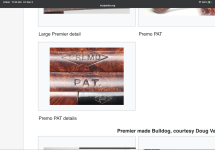 What I wanted to know was whether this was a pre-Kaywoodie pipe. I have a picture here of a patented tube/stinger. I’m wondering what era this thing might have been from if anyone knows. Thanks! Here:
What I wanted to know was whether this was a pre-Kaywoodie pipe. I have a picture here of a patented tube/stinger. I’m wondering what era this thing might have been from if anyone knows. Thanks! Here: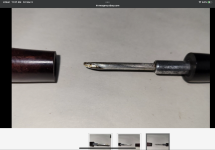 ETA: I don’t own this pipe BTW. I’m just curious at the moment. Another ETA: I’m thinking this must be a rather later pipe by Reiss-Premier. Maybe post WWII. ?
ETA: I don’t own this pipe BTW. I’m just curious at the moment. Another ETA: I’m thinking this must be a rather later pipe by Reiss-Premier. Maybe post WWII. ?
Last edited:
This is still too much and leaves my head spinning but can I ask you about a specific pipe? You’ve certainly got a clearer explanation than pipedia or, at least, it’s hard to track pipedia. I see they’ve a listing for Reiss-Premier Corp which they followed Reiss-Premier Pipes. Anyway, do you know about this one pipe they have pictured called the “Premo”? Here’s a picture from pipedia. View attachment 206577What I wanted to know was whether this was a pre-Kaywoodie pipe. I have a picture here of a patented tube/stinger. I’m wondering what era this thing might have been from if anyone knows. Thanks! Here:View attachment 206579ETA: I don’t own this pipe BTW. I’m just curious at the moment. Another ETA: I’m thinking this must be a rather later pipe by Reiss-Premier. Maybe post WWII. ?
I haven’t looked into all the Reiss-Premier models very carefully but every reference I’ve seen to R-P’s Premo dates to 1923 & 1924; in the latter year it was the subject of a determined promotion by the United Cigar Stores Company. Assuming the Premo was introduced after the formation of R-P (as seems reasonable) it would by definition have followed the introduction of the Kaywoodie pipe by at least a few years. But of course remember that in any case at that time the two pipes were made by unrelated companies; Kaywoodie was made by KB&B, which had not yet been acquired by Reiss-Premier. Of course if you have a patent number that might help with the dating too.
The Premo was a dollar pipe (cheapish by the standards of the day) and made from Italian briar which was supposedly “specially selected, very old fine grained, and extraordinarily well seasoned”. Such boasts were common and should be taken with a grain of salt. The color of the Premo was “somewhat lighter than the usual Italian briar - more of a mahogany tint”, and it possessed an “aluminum inner tube for easy cleaning”. Finally the ads boasted that the Premo, by virtue of its patented aluminum tenon, could not be broken:
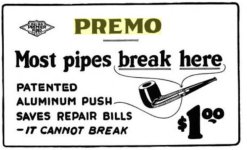
My guess, by the way, is that if a patent number could be found on a surviving Premo it would refer to this one of Burger’s:
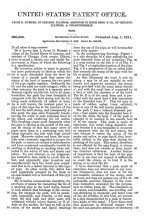
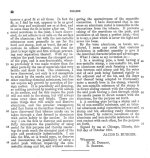

Further I’d guess that the patent was used for several models over the years including ones predating the eventual introduction of the Premo (all this part is speculation of course).



Further I’d guess that the patent was used for several models over the years including ones predating the eventual introduction of the Premo (all this part is speculation of course).
Last edited:
Amazing information. I hope it benefits others as well. Thanks so much. That’s great.My guess, by the way, is that if a patent number could be found on a surviving Premo it would refer to this one of Burger’s:
View attachment 206603
View attachment 206604
View attachment 206605
Further I’d guess that the patent was used for several models over the years including ones predating the eventual introduction of the Premo (all this part is speculation of course).








